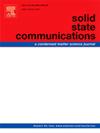Structural, microstructural, and dielectric properties of Al, Ga, and Cr based high-entropy spinel oxides
IF 2.4
4区 物理与天体物理
Q3 PHYSICS, CONDENSED MATTER
引用次数: 0
Abstract
This study investigates the structural, microstructural, and dielectric properties of high-entropy spinel oxides with compositions (Ni0.2Mg0.2Co0.2Cu0.2Zn0.2)BO, where B = Al, Ga, and Cr. X-ray diffraction (XRD) analysis confirms the formation of a single-phase cubic spinel structure (space group ) for all compositions, with minor variations in lattice parameters and crystallite size attributed to the ionic radii and electronic configurations of the B-site cations. Field-emission scanning electron microscopy (FESEM) reveals uniform particle distributions with minimal agglomeration, indicating controlled microstructural characteristics. Dielectric properties were systematically examined using complex impedance spectroscopy over a frequency range of 100 Hz to 1 MHz. The frequency-dependent dielectric permittivity and tangent loss are explained by hopping charge polarization and defect dipole formation, with the modified Debye model effectively describing the relaxation processes. The results demonstrate that the dielectric properties are significantly influenced by the B-site cation, with Al and Ga-based samples exhibiting lower tangent loss, making them suitable for high-frequency applications, while Cr-based samples show higher tangent loss, indicating potential for energy absorption applications. These findings highlight the potential of high-entropy spinel oxides as advanced functional materials for tailored dielectric applications, offering insights into the role of configurational entropy and cationic disorder in optimizing material performance.
Al、Ga和Cr基高熵尖晶石氧化物的结构、显微结构和介电性能
本文研究了高熵尖晶石氧化物(Ni0.2Mg0.2Co0.2Cu0.2Zn0.2)B2O4的结构、微观结构和介电性能,其中B = Al、Ga和Cr。x射线衍射(XRD)分析证实,所有成分都形成了单相立方尖晶石结构(空间群Fd3 * m),晶格参数和晶体尺寸的微小变化是由于B位阳离子的离子半径和电子构型。场发射扫描电镜(FESEM)显示颗粒分布均匀,团聚最小,表明微观结构特征受控。在100 Hz至1 MHz的频率范围内,使用复杂阻抗谱系统地检查了介电性能。频率相关的介电常数和正切损耗用跳电荷极化和缺陷偶极子形成来解释,改进的Debye模型有效地描述了弛豫过程。结果表明,介电性能受到b位阳离子的显著影响,Al和ga基样品具有较低的切线损耗,适合于高频应用,而cr基样品具有较高的切线损耗,表明具有能量吸收应用的潜力。这些发现突出了高熵尖晶石氧化物作为定制电介质应用的先进功能材料的潜力,为构型熵和阳离子无序在优化材料性能中的作用提供了见解。
本文章由计算机程序翻译,如有差异,请以英文原文为准。
求助全文
约1分钟内获得全文
求助全文
来源期刊

Solid State Communications
物理-物理:凝聚态物理
CiteScore
3.40
自引率
4.80%
发文量
287
审稿时长
51 days
期刊介绍:
Solid State Communications is an international medium for the publication of short communications and original research articles on significant developments in condensed matter science, giving scientists immediate access to important, recently completed work. The journal publishes original experimental and theoretical research on the physical and chemical properties of solids and other condensed systems and also on their preparation. The submission of manuscripts reporting research on the basic physics of materials science and devices, as well as of state-of-the-art microstructures and nanostructures, is encouraged.
A coherent quantitative treatment emphasizing new physics is expected rather than a simple accumulation of experimental data. Consistent with these aims, the short communications should be kept concise and short, usually not longer than six printed pages. The number of figures and tables should also be kept to a minimum. Solid State Communications now also welcomes original research articles without length restrictions.
The Fast-Track section of Solid State Communications is the venue for very rapid publication of short communications on significant developments in condensed matter science. The goal is to offer the broad condensed matter community quick and immediate access to publish recently completed papers in research areas that are rapidly evolving and in which there are developments with great potential impact.
 求助内容:
求助内容: 应助结果提醒方式:
应助结果提醒方式:


